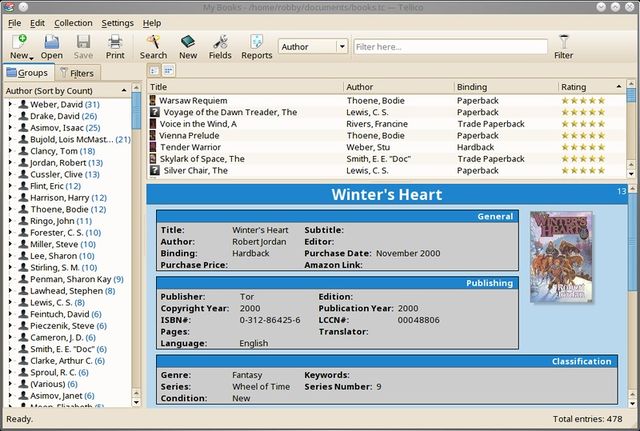Tellico/pt-br: Difference between revisions
Updating to match new version of source page |
Updating to match new version of source page |
||
| Line 43: | Line 43: | ||
Tellico use XSL files for templates, reports, import, processing data source and export. XSL files apply on XML data. | Tellico use XSL files for templates, reports, import, processing data source and export. XSL files apply on XML data. | ||
The Tellico's DTD will give you the exact name of fields (because Tellico displays translated titles instead of names). Common places for this file are /usr/share/tellico/tellico.dtd or /usr/share/kde4/apps/tellico/tellico.dtd | The Tellico's DTD will give you the exact name of fields (because Tellico displays translated titles instead of names). Common places for this file are /usr/share/tellico/tellico.dtd or /usr/share/kde4/apps/tellico/tellico.dtd | ||
Beware that Tellico use [http://xmlsoft.org/XSLT/index.html libxslt1.1] which implement [http://www.w3.org/TR/xpath XPath 1.0] functions only. Fortunately, you can use [http://www.exslt.org EXSLT] extensions. | |||
== Basical XSLT for transforming export == | == Basical XSLT for transforming export == | ||
First, do an XML export. The file will serve as a reference for testing. | First, do an XML export. The file will serve as a reference for testing. | ||
Testing will be easier if you install an XSLT processor ([http://xmlsoft.org/XSLT/xsltproc2.html xsltproc] is available on every distribution). | |||
Then write an xsl stylesheet. Here's a basic one : | Then write an xsl stylesheet. Here's a basic one : | ||
| Line 82: | Line 83: | ||
</xsl:stylesheet> | </xsl:stylesheet> | ||
</syntaxhighlight>}} | </syntaxhighlight>}} | ||
== Default fields in use for import == | == Default fields in use for import == | ||
Revision as of 15:37, 17 June 2015
| Tellico is a catalogue application, making it easy to track your books, videos, music, even your wine and anything else. A simple and intuitive interface shows cover images, groupings, and any detail you want. Grab information from many popular Internet sites, including IMDB.com, Amazon.com, and many libraries.
Tellico is a part of KDE Extragear, in the Office module |
Dando uma olhada
A janela principal do Tellico é álgo como:

Tellico can use a variety of templates for changing the formatting of the collection information.
Obtendo o Tellico
Tellico está disponível para a maioria das distribuições Linux, bem como o repositório ports para as variantes de BSD. Por favor, verifique seu gerenciador de pacotes para ver se existe um pacote está disponível por lá.
Links to many of the packages are listed on the Tellico download page.
Compiling Tellico from the source code requires installing several development packages.
Para o Ubuntu/Kubuntu existem pacotes não oficiais disponíveis em PPA.
Mais informações
- O site do Tellico é http://tellico-project.org
- A documentação de usuário do Tellico também esta disponível online.
- Dúvidas e comentários podem ser enviados para a lista de usuários Tellico.
Bugs
Para reportar bugs para o Tellico use KDE's bugzilla.
Veja todos os bugs do Tellico.
XSLT processing
Tellico use XSL files for templates, reports, import, processing data source and export. XSL files apply on XML data. The Tellico's DTD will give you the exact name of fields (because Tellico displays translated titles instead of names). Common places for this file are /usr/share/tellico/tellico.dtd or /usr/share/kde4/apps/tellico/tellico.dtd Beware that Tellico use libxslt1.1 which implement XPath 1.0 functions only. Fortunately, you can use EXSLT extensions.
Basical XSLT for transforming export
First, do an XML export. The file will serve as a reference for testing. Testing will be easier if you install an XSLT processor (xsltproc is available on every distribution). Then write an xsl stylesheet. Here's a basic one :
'"`UNIQ--syntaxhighlight-00000001-QINU`"'
Default fields in use for import
If you want to extend Tellico, you will certainly modify its XSLT processing files. To do this you will need the name of fields from the DTD, but current xsl files use several other names specific of collections and data sources. Using these default names for fields will makes your XSLT more compatible with others (for example "dewey" and "loc" are used for several data sources).
The list is built at Tellico/DefaultFields

